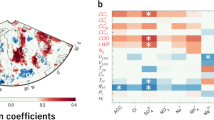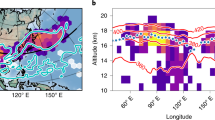Abstract
It is now generally accepted that springtime Antarctic ozone depletion in the atmosphere between 17 and 22 km is related to the presence of ClO produced through heterogeneous chemistry on the surface of polar stratospheric cloud particles1,2. Below 17 km, however, where ozone depletion also occurs3, a causal link with ClO has not been established because of apparently low ClO values. Vertical motions, associated with mountain lee waves and the formation of nacreous clouds, also seemingly cannot explain observed ozone depletion4. Here we present balloon measurements of ozone and cloud particles in the lower stratosphere (10–17 km) at McMurdo Station (787° N), Antarctica, on 9 September 1988 which indicate that the cloud particles are directly involved in ozone depletion in this region. The reductions in ozone appear to be correlated with high concentrations of smaller particles, of about 0.2 micrometre radius, which dominate the surface area density in the cloud. The observations suggest a high degree of spatial inhomogeneity of free chlorine, associated with lower stratospheric clouds, and are important in understanding ozone depletion in this region.
This is a preview of subscription content, access via your institution
Access options
Subscribe to this journal
Receive 51 print issues and online access
$199.00 per year
only $3.90 per issue
Buy this article
- Purchase on Springer Link
- Instant access to full article PDF
Prices may be subject to local taxes which are calculated during checkout
Similar content being viewed by others
References
De Zafra, R. L. et al. Nature 328, 408–411 (1987).
Anderson, J. G., Brune, W. H., Proffitt, M. J., Starr, W. & Chan, K. R. J. geophys. Res. (in the press).
Hofmann, D. J., Harder, J. W., Rolf, S. R. & Rosen, J. M. Nature 326, 59–62 (1987).
Hofmann, D. J., Harder, J. W., Rosen, J. M., Hereford, J. V. & Carpenter, J. R. J. geophys. Res. (in the press).
Hofmann, D. J., Rosen, J. M., Harder, J. W. & Hereford, J. V. J. geophys. Res. (in the press).
Hanson, D. & Mauersberger, K. Geophys. Res. Lett. 15, 855–858 (1988).
Rosen, J. M., Hofmann, D. J., Carpenter, J. R., Harder, J. W. & Oltmans, S. J. Geophys. Res. Lett. 15, 859–862 (1988).
Rosen, J. M., Hofmann, D. J. & Harder, J. W. J. geophys. Res. 93, 677–686 (1988).
Hofmann, D. J., Rosen, J. M. & Harder, J. W. J. geophys. Res. 93, 665–676 (1988).
Komhyr, W. D., Oltmans, S. J. & Grass, R. D. J. geophys. Res. 93, 5167–5184 (1988).
Gardiner, B. G. Geophys. Res. Lett. 15, 901–904 (1988).
Author information
Authors and Affiliations
Rights and permissions
About this article
Cite this article
Hofmann, D. Direct ozone depletion in springtime Antarctic lower stratospheric clouds. Nature 337, 447–449 (1989). https://doi.org/10.1038/337447a0
Received:
Accepted:
Issue Date:
DOI: https://doi.org/10.1038/337447a0
This article is cited by
-
Evidence from balloon measurements for chemical depletion of stratospheric ozone in the Arctic winter of 1989–90
Nature (1991)
-
Antarctica and global change
Climatic Change (1991)
-
Denitrification through PSC formation: A 1-D model incorporating temperature oscillations
Journal of Atmospheric Chemistry (1991)
-
Polar stratospheric clouds and ozone depletion: Relevance of extendedin situ observations
Il Nuovo Cimento C (1990)
-
Stratospheric clouds and ozone depletion in the Arctic during January 1989
Nature (1989)
Comments
By submitting a comment you agree to abide by our Terms and Community Guidelines. If you find something abusive or that does not comply with our terms or guidelines please flag it as inappropriate.



